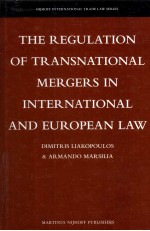

The Regulation of Transnational Mergers in International and European LawPDF电子书下载
- 电子书积分:10 积分如何计算积分?
- 作 者:Liakopoulos
- 出 版 社:BRILL
- 出版年份:2009
- ISBN:9789004177710;900417771X
- 页数:233 页
Introduction 1
Ⅰ. The aim of the book 1
Ⅱ. The problems regarding the regulation of trans-national mergers 2
Ⅲ. The structure of the book 5
Chapter One The Unilateral Strategy 7
Ⅰ. Introduction 7
Ⅱ. The concept of extraterritorial jurisdiction 8
Ⅲ. The grounds of extraterritorial jurisdiction 10
Ⅳ. The unilateral strategy and competition law 13
Ⅴ. The US and EC positions for extraterritorial application of competition law 13
Ⅵ. Extraterritorial application of competition law to merger cases 21
Ⅶ. The demise of the unilateral strategy 29
Ⅷ. Conclusion 32
Chapter Two A Comparative Analysis of EC and US Merger Control Law: The Institutional Framework and Procedural Rules 35
Ⅰ. Introduction 35
Ⅱ. The history of US merger control law 35
Ⅲ. The history of EC merger control law 36
Ⅳ. Introduction to the EC/US bilateral cooperation 38
Ⅴ. The institutional framework 39
Ⅵ. Procedural rules 46
Ⅶ. Differences between EC and US institutional framework and procedural rules: Possible consequences on the outcome of mergers review 48
Ⅷ. Criticism of the EC Courts regarding Commission's administration of merger control 54
Ⅸ. The new EC Regulation 139/2004 and its impact on EC merger control regime 57
Ⅹ. The soft law initiatives of the Commission to amend the EC merger control regime 58
Ⅺ. Conclusion 59
Chapter Three A Comparative Analysis of EC and US Merger Control Law: The Substantive Rules 61
Ⅰ. Introduction 61
Ⅱ. Substantive assessment of mergers: Introductory remarks 61
Ⅲ. Definition of relevant markets 63
Ⅳ. Evaluation of anti-competitive effects of mergers 64
Ⅴ. A comparative analysis of the scope of application of the market dominance test and of the substantial lessening of competition test 68
Ⅵ. The Boeing/McDonnell Douglas merger 73
Ⅶ. The General Electric/Honeywell merger 74
Ⅷ. Regulation of foreclosure effects 77
Ⅸ. The EC and US different approaches to regulation of mergers between large firms: Possible explanations 87
Ⅹ. Final thoughts on convergence and divergence between EC and US merger control laws 96
Ⅺ. Conclusion 98
Chapter Four A Comparative Analysis of Merger Control Laws Enacted by Other Jurisdictions 101
Ⅰ. Introduction 101
Ⅱ. Institutional frameworks 101
Ⅲ. Procedural rules 103
Ⅳ. Substantive rules 107
Ⅴ. Major implications of differences in national merger control laws 109
Ⅵ. Conclusion 111
Chapter Five The Bilateral Strategy 113
Ⅰ. Introduction 113
Ⅱ. The origins of bilateral cooperation 114
Ⅲ. Contributions of the OECD to the development of international cooperation 117
Ⅳ. The EC/US bilateral cooperation 117
Ⅴ. Regional Trade Agreements 125
Ⅵ. European Regional Agreements 129
Ⅶ. Competition rules of European Regional Agreements and regulation of transnational restrictive business practices 131
Ⅷ.A critical review of competition rules of European Association Agreements and of Regional Trade Agreements 134
Ⅸ. A Critical review of the bilateral strategy 135
Ⅹ. The bilateral strategy and regulation of transnational mergers 140
Chapter Six Multilateral Strategy: Instruments of Hard Law 143
Ⅰ. Introduction 143
Ⅱ. First attempts to create multinational competition rules 144
Ⅲ. The first steps of the proposal for WTO competition rules: From the Van Miert Report to Singapore 146
Ⅳ. Arguments for WTO multilateral competition rules 146
Ⅴ. Arguments against WTO multilateral competition rules 148
Ⅵ. On the road towards Cancun Conference 152
Ⅶ. The failure of the Cancun Conference. Is it the end of WTO competition rules? 155
Ⅷ. An alternative approach for the creation of multilateral competition rules: The theory of market access developed by Professor Fox 157
Ⅸ. Multilateral instruments of hard law as regulatory tools for transnational Mergers. Prospects and problems 161
Ⅹ. Conclusion 166
Chapter Seven Multilateral Strategy: Instruments of Soft Law 167
Ⅰ. Introduction 167
Ⅱ. The UNCTAD Set 167
Ⅲ. The initiatives of the OECD 169
Ⅳ. The International Competition Network 170
Ⅴ. Soft law international cooperation in the financial services sector 172
Ⅵ. Lessons from international cooperation in the financial services sector 176
Ⅶ. Building a feasible international framework for regulation of transnational mergers 177
Ⅷ. The definition of “transnational” mergers 178
Ⅸ. The concepts of legitimacy and efficiency 179
Ⅹ. The International Competition Principles 180
Ⅺ. Harmonisation of substantive rules 193
Ⅻ. The extrinsic dimension of efficiency 197
ⅩⅢ. Arguments for the creation of the International Framework for Merger Control: A summary 200
ⅩⅣ. Conclusion 202
Conclusions 205
List of Abbreviations 213
Bibliography 215
Index 231
